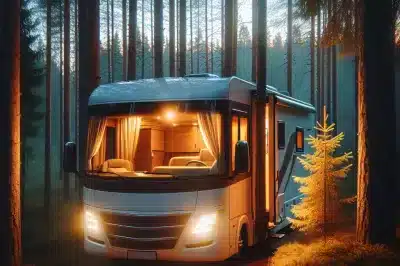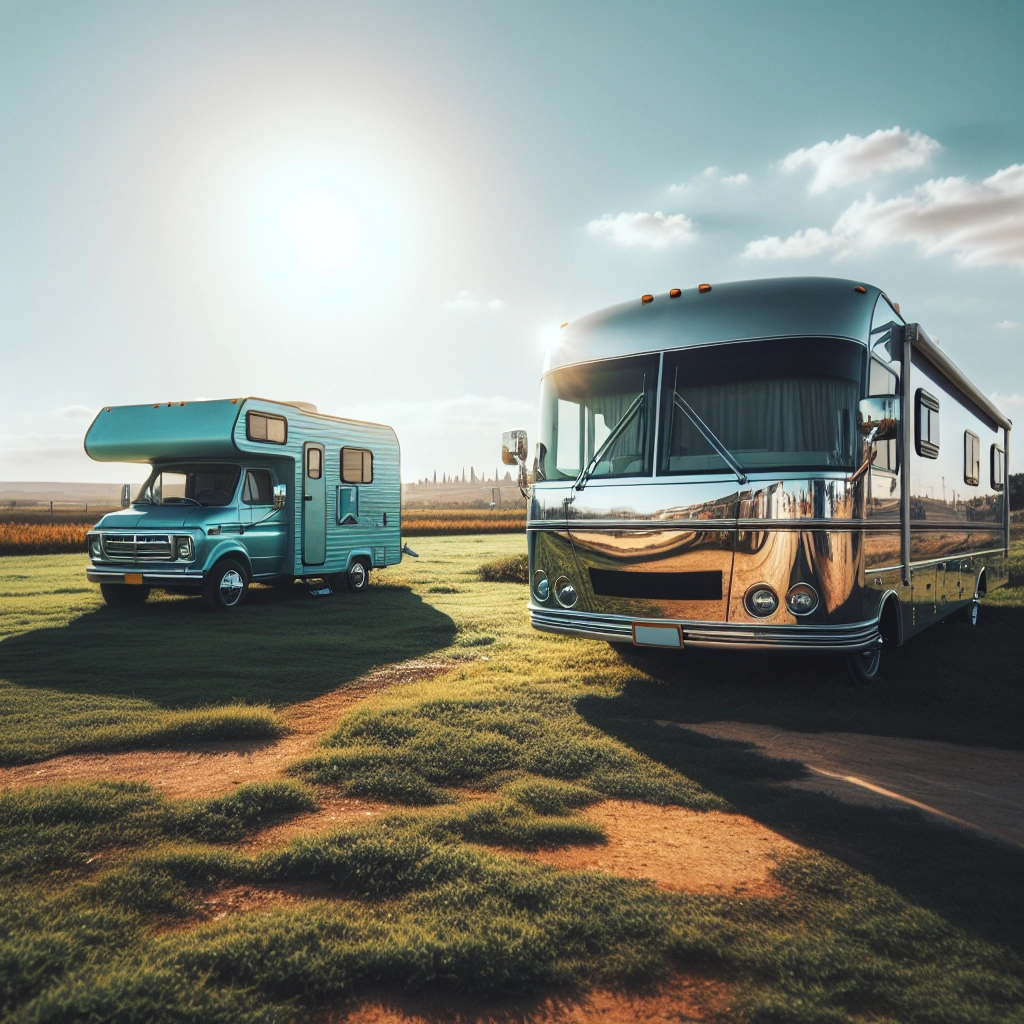Table of Contents

Empower Your Boondocking Adventures with the Right Power Station
Imagine the freedom of exploring the great outdoors without ever worrying about finding the next power hookup. That’s the beauty of boondocking with a reliable portable power station. Whether you’re parked in a secluded forest, beside a tranquil lake, or in the midst of a desert’s expanse, the right power station ensures your RV becomes a self-sufficient home away from home.
Key Takeaways
- Discover how portable power stations can revolutionize your boondocking experience.
- Learn to identify your power needs to choose the perfect power station for your RV.
- Understand the limitations of traditional generators and why solar power is a superior choice.
- Gain insights into the basics of solar power for off-grid living.
- Equip yourself with the knowledge to make an informed decision on the best portable power station for your needs.
Navigating the Boondocking Power Dilemma
Boondocking, or dry camping, is all about independence and getting closer to nature. But let’s face it, we all need power for essentials like lighting, refrigeration, and charging devices. The challenge is to maintain that power supply without the convenience of a campground’s electrical hookup. This is where portable power stations come into play, offering a bridge between the desire for remote adventures and the need for electricity.
Understanding Boondocking Power Needs
Before diving into the world of portable power stations, it’s crucial to assess your energy requirements. Start by listing all the devices and appliances you’ll use in your RV. Think about your daily activities: How much time do you spend inside? Do you cook with electric appliances? How often do you need to charge your gadgets? These questions will help you estimate the watt-hours needed to keep everything running smoothly during your off-grid excursions.
The Shortcomings of Traditional Generators
Generators have long been the go-to for RV power, but they come with downsides. They’re noisy, which can disrupt the peace of the wilderness, and they emit fumes, which isn’t ideal for the environment or your health. Moreover, they require a steady supply of fuel, which isn’t always practical or cost-effective when you’re far from civilization. It’s clear that a better solution is needed for the eco-conscious boondocker.

Solar-Powered Solutions: Harnessing the Sun for Your RV
Solar power stations are a game-changer for boondocking. They’re quiet, clean, and harness the abundant energy of the sun. With advancements in technology, they’ve become more efficient and affordable, making them accessible to more RV enthusiasts. By choosing solar, you’re not only powering your RV; you’re also contributing to a greener planet.
The Basics of Solar Power for Boondocking
Understanding solar power is simpler than you might think. Solar panels capture sunlight and convert it into electricity, which is then stored in a battery within the power station. This stored energy is what you’ll use to power your RV’s appliances. The capacity of your power station and the efficiency of your solar panels will determine how much power you can generate and store. It’s a straightforward and incredibly effective way to stay powered up while off the grid.
Advantages of Portable Solar Power Stations
Portable solar power stations are a boon for the modern boondocker. They’re eco-friendly, harnessing renewable energy without the need for fossil fuels. They operate silently, preserving the serene sounds of nature that you seek out in your travels. Maintenance is minimal, and the convenience factor is high—there’s no need to worry about running out of gas or dealing with engine issues. Plus, they’re safe to use indoors and won’t produce any hazardous emissions.
Criteria for Selecting the Best Portable Power Station
Choosing the right portable power station is critical to a successful boondocking experience. It’s not just about picking the most expensive or the one with the most features; it’s about finding the one that fits your specific energy needs and travel style. Let’s walk through the essential criteria to consider, ensuring you make a choice that will keep your adventures powered up without a hitch.
Analyzing Power Capacity and Output
The heart of a portable power station is its capacity, measured in watt-hours (Wh). This tells you how much energy the station can store and deliver. Think about the devices you’ll be powering—fridges, lights, laptops—and tally up their power requirements. Ensure the station you choose can handle your peak power draw, and has enough capacity to keep your essentials running between charges.
Portability and Durability Considerations
When you’re on the move, your power station should be too. Weight and size are key; it should be light enough to carry but robust enough to withstand the rigors of the road. Look for a power station with a sturdy build, and consider features like water resistance and dustproof ratings, especially if you’re an all-weather adventurer.
Compatibility with Solar Panels
Your portable power station should play nice with solar panels. Check the input specifications to ensure the station can be efficiently charged by the solar panels you have or plan to buy. Some power stations come with built-in solar controllers, making them a plug-and-play solution for solar charging.
Additional Features Worth Considering
Beyond the basics, modern power stations offer extra features that can enhance your boondocking experience. Look for USB ports for easy device charging, integrated lighting for those dark nights, and even wireless charging pads for convenience. Some models offer smart features like app connectivity to monitor and control the station remotely.

Top Portable Power Stations for Boondocking RVs Reviewed
With the criteria set, let’s explore some of the top portable power stations that have been put to the test in the boondocking scene. Each model has been evaluated for its power capacity, ease of use, durability, and compatibility with solar panels, ensuring they meet the needs of even the most adventurous RV owner.
Eco-Friendly and Efficient: Model A
Model A stands out as a champion of eco-efficiency. With its impressive energy storage capacity, it can keep your essentials running for days on end. It’s engineered to work seamlessly with solar panels, making it a breeze to charge using the power of the sun. The robust build quality ensures it can withstand the bumps and jolts of life on the road, while its lightweight design doesn’t add much to your RV’s payload.
Compact Powerhouse: Model B
Don’t let the small size of Model B fool you; this portable power station packs a punch. It’s perfect for those who prioritize space-saving without compromising on power. With multiple output options, it’s versatile enough to charge everything from smartphones to portable fridges. Its intuitive display keeps you informed of the remaining battery life, so you’re never caught off guard.
Off-the-Grid Reliability: Model C
For the rugged boondocker, Model C offers unmatched reliability. It’s built to endure the harshest environments, with a focus on long-term durability. The power output is steady and strong, capable of handling high-drain appliances with ease. When you’re miles from the nearest power source, Model C gives you the confidence to stay connected and comfortable.
The Long-Lasting Power Solution: Model D
Model D is the marathon runner of portable power stations. Its high-capacity battery ensures that you can go longer between charges, making it ideal for extended stays in remote locations. The efficient inverter delivers clean power, which is kinder to sensitive electronics. With Model D, you’re investing in a power station that’s designed for the long haul.
Integrated Solar Tech Power Station: Model E
Model E is a standout with its integrated solar technology. It’s designed for those who want a streamlined solar charging experience without the hassle of external controllers. The built-in MPPT charge controller optimizes the charging process, ensuring you get the most out of your solar panels. It’s a smart, all-in-one solution for the tech-savvy boondocker.
Making the Most of Your Portable Power Station
Having chosen the perfect portable power station for your RV, it’s essential to know how to get the most out of it. Proper usage and maintenance can significantly extend the life of your power station, ensuring it serves you well for many adventures to come. Let’s go over some tips to help you maximize your investment.
Tips for Maximizing Battery Life
- Avoid fully depleting the battery; recharge it before it drops below 20% to prolong its lifespan.
- Store your power station in a cool, dry place when not in use, as extreme temperatures can degrade battery performance.
- Regularly cycle the battery by using and recharging it, even during periods of inactivity, to keep it in good condition.
- Use energy-efficient appliances and LED lighting in your RV to reduce the overall power draw on your station.
- Keep the power station clean and dust-free, especially the ports and connectors, to ensure efficient operation.
- Charge the power station with solar panels during peak sunlight hours for the most efficient energy conversion.
- Monitor the power station’s usage through any available apps or displays to manage your energy consumption effectively.
Best Practices for Solar Charging
Maximizing the efficiency of solar charging isn’t just about plugging in and hoping for the best. It’s about understanding the sun’s path, the weather, and your equipment. Always position your solar panels to face direct sunlight and adjust the angle as the sun moves across the sky. Clean your panels regularly to remove dust and debris that can block sunlight. Also, use high-quality cables and connectors to reduce energy loss. Remember, the best solar charging happens under clear skies, from mid-morning to late afternoon, when the sun is at its strongest.
Maintenance and Care Guide
Keeping your portable power station in tip-top shape is straightforward but essential. First, always follow the manufacturer’s instructions for care and maintenance. Charge the station regularly, even when not in use, to keep the battery healthy. Avoid exposing it to moisture or extreme temperatures, both of which can harm the battery and electronics. If your power station has a fan, ensure it’s not obstructed to prevent overheating. And finally, store your power station in a protective case if possible, especially when traveling, to shield it from bumps and scrapes.
Seamless Power in Remote Locations
With the right portable power station, you can enjoy the comforts of home even in the most remote locations. These stations provide a seamless power supply, ensuring your lights stay on, your fridge stays cold, and your devices stay charged. They bridge the gap between the ruggedness of the wild and the convenience of modern technology, allowing you to immerse yourself in nature without sacrificing comfort or connectivity.
Experiences of Empowered Boondocking
There’s something magical about watching the sunset from your RV, knowing that you have the power you need without a cord in sight. Many boondockers share stories of how their portable power stations have enabled them to stay longer in the wild, capturing breathtaking photographs, or simply enjoying the peace that comes with self-sufficiency. These experiences are a testament to the freedom that solar power can provide to RV enthusiasts.
The Future of Off-Grid RV Power
The future of off-grid RV power is bright, with innovations in solar technology and battery storage continually advancing. We’re seeing a trend towards more efficient solar panels, higher capacity batteries, and even smarter power stations that can be monitored and controlled via smartphone apps. As renewable energy technology evolves, boondockers can expect to see even more powerful and user-friendly solutions that will make sustainable living on the road easier than ever.
Frequently Asked Questions (FAQ)
What is the average lifespan of a portable power station battery?
The lifespan of a portable power station battery depends on several factors, including the type of battery, the number of charge cycles, and how it’s used and maintained. On average, a quality lithium-ion battery can last between 500 to 1000 charge cycles before its capacity starts to diminish. With proper care, this translates to several years of reliable service. To extend your battery’s life, avoid deep discharges, keep it at a moderate temperature, and store it with a partial charge if you won’t be using it for an extended period.
Can I power my entire RV using a portable power station?
Yes, it’s possible to power your entire RV with a portable power station, but it depends on the size of your RV and your power consumption. Smaller RVs with fewer power demands can easily be powered by a high-capacity power station. For larger RVs, you may need to prioritize which appliances and devices are essential. Consider energy-efficient appliances and LED lighting to reduce power consumption. It’s all about matching your power needs with the right station’s capacity.
How do I know if a power station is compatible with my solar panels?
To ensure compatibility between your power station and solar panels, check the voltage and current specifications of both. The power station should have an input voltage range that matches the output of your solar panels. Additionally, the connectors should be compatible or adaptable. If your power station has a built-in MPPT (Maximum Power Point Tracking) charge controller, it will more efficiently convert solar energy and is likely to be compatible with a wider range of solar panels.
What is the best way to store a portable power station when not in use?
When storing your portable power station, keep it in a cool, dry place to prevent battery degradation. Avoid locations where temperatures fluctuate extremely. It’s best to store the power station with a charge level between 50-80% and recharge it every three to six months to keep the battery in optimal condition. If the power station has an LCD screen, keep it away from direct sunlight to prevent screen damage.
In conclusion, portable power stations are a versatile and eco-friendly solution for boondocking RV enthusiasts. They offer the freedom to explore off-grid locations without sacrificing the comforts of home. By understanding your power needs, choosing a compatible power station, and following best practices for use and storage, you can ensure a reliable power supply for your adventures. The future of RVing looks bright with solar power, and with the right portable power station, you’re well-equipped to enjoy the journey wherever it may lead.
- Boondocking RVs: Flexible Solar Solutions – 3 March 2024
- Renewable Energy Tips for Full-Time Boondocking RVers – 2 March 2024
- Boondocking Solar Power Systems: Sizing Options & Solutions for Motorhomes – 1 March 2024
